 To enhance service speed and avoid tariff delays, we've opened a US warehouse. All US orders ship directly from our US facility.
To enhance service speed and avoid tariff delays, we've opened a US warehouse. All US orders ship directly from our US facility.
| Cat. No. | Product Name | Field of Application | Chemical Structure |
|---|---|---|---|
| DC46353 | PEG-8 laurate Featured |
PEG-8 laurate is a single chain surfactant. PEG-8 laurate reduces the skin barrier, and acts as a penetration enhancer. PEG-8 laurate can be used to synthesize elastic vesicles.
More description
|
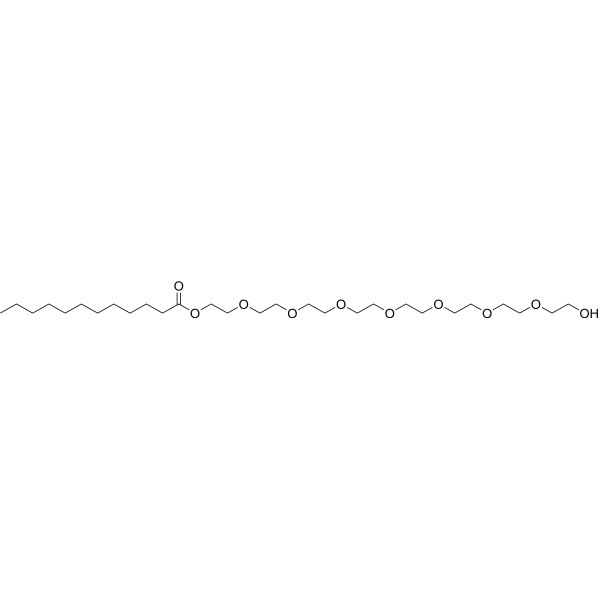
|
| DC77017 | 9(10)-Nitrooleate Featured |
9(10)-Nitrooleate (9(10)-Nitrated oleic acid) is a nitrated derivative of Oleic acid (HY-N1446). 9(10)-Nitrooleate can activate PPAR (PPARα, PPARβ/δ, and PPARγ), promoting fat formation and glucose uptake, inhibiting the function of neutrophils and platelets, and can be used in lipid metabolism and inflammation research.
More description
|
-Nitrooleate.gif)
|
| DC21360 | MZ1 Featured |
MZ1 is a PROTAC that tethers JQ1 to a ligand for the E3 ubiquitin ligase VHL, triggers, induces degradation of the BET bromodomain BRD4.
More description
|
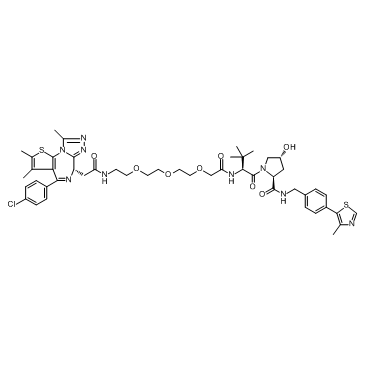
|
| DC21794 | VH 298 Featured |
A potent, specific cell-active VHL E3 ubiquitin ligase inhibitor that inhibits VHL/HIF-α interaction with Kd of 90 nM in ITC assays.
More description
|
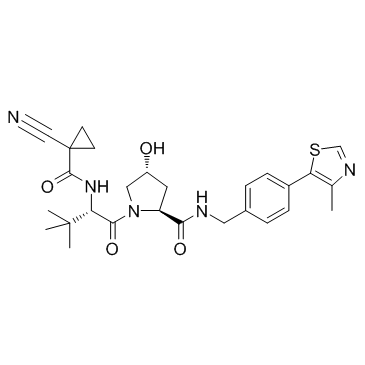
|
| DC28688 | UNC6852 Featured |
UNC6852 is a selective rolycomb repressive complex 2 (PRC2) degrader based on PROTAC and contains an EED (embryonic ectoderm development) ligand and a VHL ligand, with an IC50 of 247 nM for EED.
More description
|
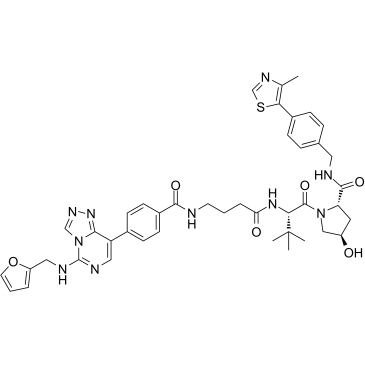
|
| DC12191 | JQ-35-(S) Featured |
JQ-35, (S)- is an inhibitor of the Bromodomain and Extra-Terminal (BET) family bromodomain-containing proteins with potential antineoplastic activity.
More description
|

|
| DC73960 | CW4142 Featured |
CW4142 (CW 4142) is a small molecule SC4MOL inhibitor that enhances oligodendrocyte formation.
More description
|
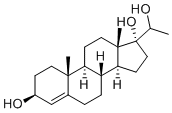
|
| DCC4292 | Psb-18422 Featured |
Novel Potent Agonist of the Orphan G Protein-Coupled Receptor GPR17 (EC 50 27.9 nM)
More description
|

|
| DC73618 | NUCC-0200590 Featured |
NUCC-0200590 is a small-molecule inhibitor of the TRIP8b-HCN interaction with IC50 of 7.0 uM in AlphaScreen assays, effectively disrupts the TRIP8b-HCN interaction in vitro and in vivo.
More description
|
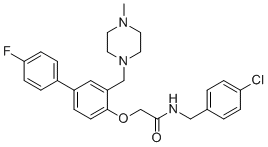
|
| DC46940 | AZD4694 Featured |
AZD4694, a fluorinated β-amyloid (Aβ) plaque neuroimaging PET radioligand, shows high affinity for Aβ fibrils (Kd = 2.3 nM).
More description
|

|
| DC22200 | PMX53 Featured |
PMX53 (Ac-Phe-cyclo(Orn-Pro-D-Cha-Trp-Arg)) is a potent C5a receptor (CD88) antagonist with IC50 of 20 nM, also is an agonist for Mas-related gene 2 (MrgX2) in human mast cells; PMX-53 (10 nM) inhibited C5a-induced Ca(2+) mobilization in HMC-1 cells, but at higher concentrations (>30 nM) it caused degranulation in LAD2 mast cells, CD34(+) cell-derived mast cells, and RBL-2H3 cells stably expressing MrgX2; inhibits zymosan-, carrageenan-, LPS- and antigen-induced hypernociception in rats.
More description
|
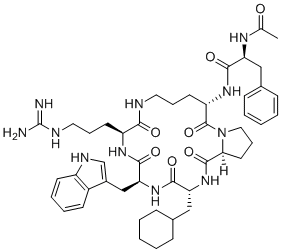
|
| DC31423 | DM4 Featured |
Maytansinoid DM4, a chemical derivative of maytansine, is a potent and selective cytotoxic agent with promising anticancer properties. Anticancer properties of maytansinoids have been attributed to their ability to disrupt microtubule function. Maytansin
More description
|

|
| DC33119 | Sodium taurocholate Featured |
Sodium taurocholate is a GPBAR1 protein agonist potentially for the treatment of type 2 diabetes and obesity in rats.
More description
|

|
| DCC4924 | St-2262 Featured |
Novel selective NaV1.7 inhibitor, blocking the extracellular vestibule of the channel with an IC50 of 72 nM and greater than 200-fold selectivity over off-target sodium channel isoforms, NaV1.1-1.6 and NaV1.8
More description
|

|
| DC79869 | Z218484536 |
Z218484536 is a selective and brain-penetrant phosphoserine phosphatase (PSPH) inhibitor. Z218484536 binds to PSPH with a Kd value of approximately 0.23 μM. Z218484536 reduces L-serine and D-serine levels in astrocytes. Z218484536 is able to suppress spontaneous epileptic seizures without causing serious side effects. Z218484536 also shows good anti-epileptic effects in the temporal lobe epilepsy (TLE) model.
More description
|

|
| DC79868 | F4-Trp |
F4-Trp (4,5,6,7-Tetrafluoro-L-tryptophan) is a ligand targeting the α3β4 nicotinic acetylcholine receptor (α3β4 nAChR). F4-Trp is promising for research of neurotransmission, addiction, and related diseases, such as neurological diseases.
More description
|

|
| DC79867 | GGACK hydrochloride |
GGACK (H-Glu-Gly-Arg-CMK) hydrochloride is an irreversible substrate-like serine protease urokinase-type plasminogen activator (uPA) inhibitor.
More description
|

|
| DC79866 | IDOR-1104-0086 |
IDOR-1104-0086 is an orally active Kv7 potassium channel opener with an EC50 of 210 nM that can cross blood-brain barrier. IDOR-1104-0086 displays strong selectivity against the hERG channel with an IC20 of 25 μM. IDOR-1104-0086 exhibits efficacy in two rodent models of epilepsy and a favorable tolerability profile. IDOR-1104-0086 can used for the study of epilepsy.
More description
|

|
| DC79865 | FHND5032 |
FHND5032 is an orally active miR-124 inducer. FHND5032 significantly upregulates miR-124 expression in macrophages. FHND5032 disrupts inflammatory signaling, promotes macrophage reprogramming, and restores the epithelial barrier function by inhibiting the PIK3R2/PI3K/Akt axis. FHND5032 alleviates colitis and reduces inflammatory burden in ulcerative colitis mice. FHND5032 can be used for the study of ulcerative colitis.
More description
|

|
| DC79864 | 7,4'-Dimethoxy-3-hydroxyflavone |
7,4'-Dimethoxy-3-hydroxyflavone is an orally active PAR4 antagonist. 7,4'-Dimethoxy-3-hydroxyflavone inhibits PAR4-mediated human platelet aggregation with an IC50 of 1.4 μM. 7,4'-Dimethoxy-3-hydroxyflavone inhibits PAR4-mediated human platelet aggregation and PAR4 signaling pathways, including NF-κB, Ca2+/protein kinase C, Akt, ERK and p38. 7,4'-Dimethoxy-3-hydroxyflavone prevents vascular PAR4 expression, endothelial dysfunction and ameliorates oxidative stress in Streptozotocin (STZ)-induced diabetic mice. 7,4'-Dimethoxy-3-hydroxyflavone prevents thrombosis in mice without affecting bleeding time[1][2].
More description
|

|
| DC79863 | DC-5163 |
DC-5163 is a potent glyceraldehyde-3-phosphate dehydrogenase (GAPDH) inhibitor with an IC50 of 176.3 nM and a Kd of 3.192 μM. DC-5163 can inhibit glycolysis pathway partially. DC-5163 also selectively inhibits cancer cell proliferation and induces apoptosis.
More description
|

|
| DC79862 | α-MSH (11-13) acetate |
α-MSH (11-13) acetate is the 11-13 amino acid (lysine-proline-valine) sequence of α-MSH, which reduces fever in rabbits.
More description
|

|
| DC79861 | MT-228 |
MT-228 (BPN-0026709) is a selective and blood-brain barrier permeable non-muscle myosin II inhibitor. MT-228 markedly improves tolerability by selectively targeting NMIIB (KI = 1.5 μM) over CMII (KI = 17 μM), and the sequence of SmMll MD is 83.6% identical to that of NMllB. MT-228 shows long-lasting efficacy in animal models of stimulant use disorder.
More description
|

|
| DC79860 | I3IN-002 |
I3IN-002 is a small-molecule RNA-binding protein IGF2BP3 inhibitor with an IC50 value of approximately 2 μM in SEM cells. I3IN-002 interferes with interaction with m6 A-modified mRNAs, disrupting the stabilization of target genes (such as CDK6, MYC, and BCL2) to inhibit leukemic cell growth, induce cell cycle arrest, and promote apoptosis. I3IN-002 is promising for research of B-cell acute lymphoblastic leukemia.
More description
|

|
| DC79859 | SW016789 |
SW016789 is a hypersecretion-inducer targeting VDAC1. SW016789 can induce insulin hypersecretion and Ca2+ influx in β-cells directly. SW016789 induces a transient endoplasmic reticulum stress response (ER stress), but does not cause beta cell death. SW016789 has reversible and non-apoptotic characteristics. SW016789 can be used for the study of Diabetes mellitus type 2 (T2DM) β-cell dysfunction.
More description
|

|
| DC79858 | Tecarfarin |
Tecarfarin (ATI-5923) is an orally active and non-competitive vitamin K epoxide reductase (VKOR) antagonist, and impairs the activation of the vitamin K-dependent clotting factors II, VII, IX and X. Tecarfarin has the antithrombotic activity .
More description
|

|
| DC79857 | GLPG4471 |
GLPG4471 is a selective and orally active IRAK4 inhibitor with an IC50 of 1.7 nM. GLPG4471 exhibits potent inhibition of cytokine (TNFα and IFNα) secretion in cellular and whole blood phenotypic assays. GLPG4471 displays significant activity in a mouse model of collagen-induced arthritis. GLPG4471 can be used for the study of arthritis.
More description
|

|
| DC79856 | EVT0185 |
EVT0185 is an orally active ATP citrate lyase (ACLY) inhibitor. EVT0185 is converted to a CoA thioester in the liver by SLC27A2 and interacts with the CoA-binding site of ACLY. EVT0185-CoA inhibits ACLY activity with an IC50 of 2.5 μM. EVT0185 can phenocopy the immune and antitumour effects of genetic ACLY deletion. EVT0185 can increase tumour-infiltrating B cells and chemokine CXCL13 levels. EVT0185 can be used for the research of cancer, such as hepatocellular carcinoma (HCC).
More description
|

|
| DC79855 | LY3526318 |
LY3526318 is an orally active, selective TRPA1 antagonist (IC50=5-6μM). LY3526318 blocks TRPA1 channels, inhibits pain signal transduction mediated by the channel, and exerts analgesic activity. LY3526318 is mainly used in the research of chronic pain-related fields, such as diabetic peripheral neuropathy, chronic low back pain, and pain caused by osteoarthritis.
More description
|

|
| DC79854 | Voderdeucitinib |
Voderdeucitinib (Compoudn I) is a TYK2 inhibitor with an anti-inflammatory activity. Voderdeucitinib can be used for inflammatory and autoimmune disease research, such as rheumatoid arthritis (RA), multiple sclerosis and intestinal bowel disease (IBD).
More description
|

|